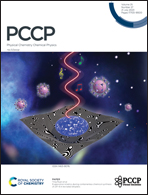Prediction of toluene/water partition coefficients in the SAMPL9 blind challenge: assessment of machine learning and IEF-PCM/MST continuum solvation models†
Abstract
In recent years the use of partition systems other than the widely used biphasic n-octanol/water has received increased attention to gain insight into the molecular features that dictate the lipophilicity of compounds. Thus, the difference between n-octanol/water and toluene/water partition coefficients has proven to be a valuable descriptor to study the propensity of molecules to form intramolecular hydrogen bonds and exhibit chameleon-like properties that modulate solubility and permeability. In this context, this study reports the experimental toluene/water partition coefficients (log Ptol/w) for a series of 16 drugs that were selected as an external test set in the framework of the Statistical Assessment of the Modeling of Proteins and Ligands (SAMPL) blind challenge. This external set has been used by the computational community to calibrate their methods in the current edition (SAMPL9) of this contest. Furthermore, the study also investigates the performance of two computational strategies for the prediction of log Ptol/w. The first relies on the development of two machine learning (ML) models, which are built up by combining the selection of 11 molecular descriptors in conjunction with either the multiple linear regression (MLR) or the random forest regression (RFR) model to target a dataset of 252 experimental log Ptol/w values. The second consists of the parametrization of the IEF-PCM/MST continuum solvation model from B3LYP/6-31G(d) calculations to predict the solvation free energies of 163 compounds in toluene and benzene. The performance of the ML and IEF-PCM/MST models has been calibrated against external test sets, including the compounds that define the SAMPL9 log Ptol/w challenge. The results are used to discuss the merits and weaknesses of the two computational approaches.

- This article is part of the themed collection: The SAMPL Challenges


 Please wait while we load your content...
Please wait while we load your content...